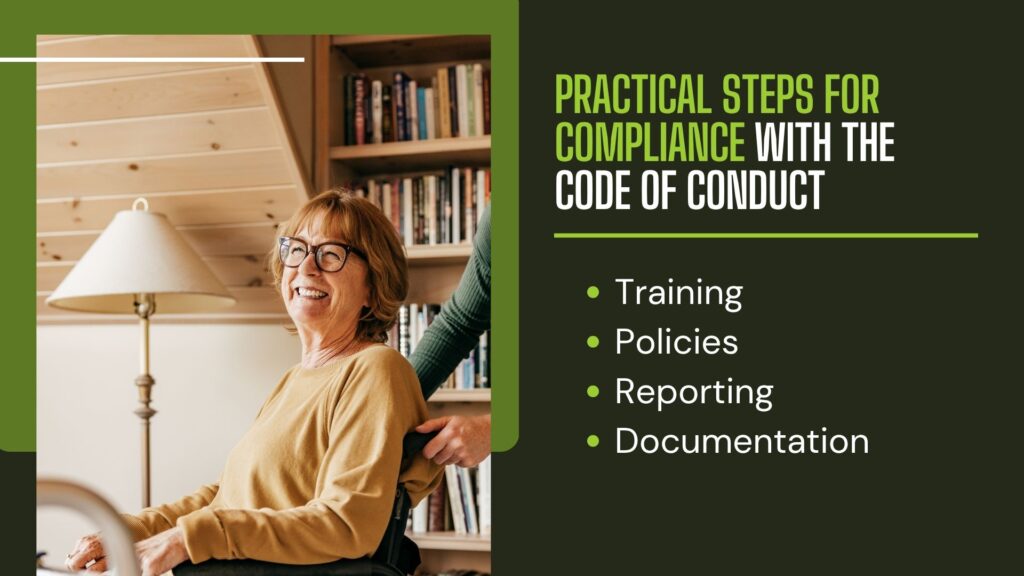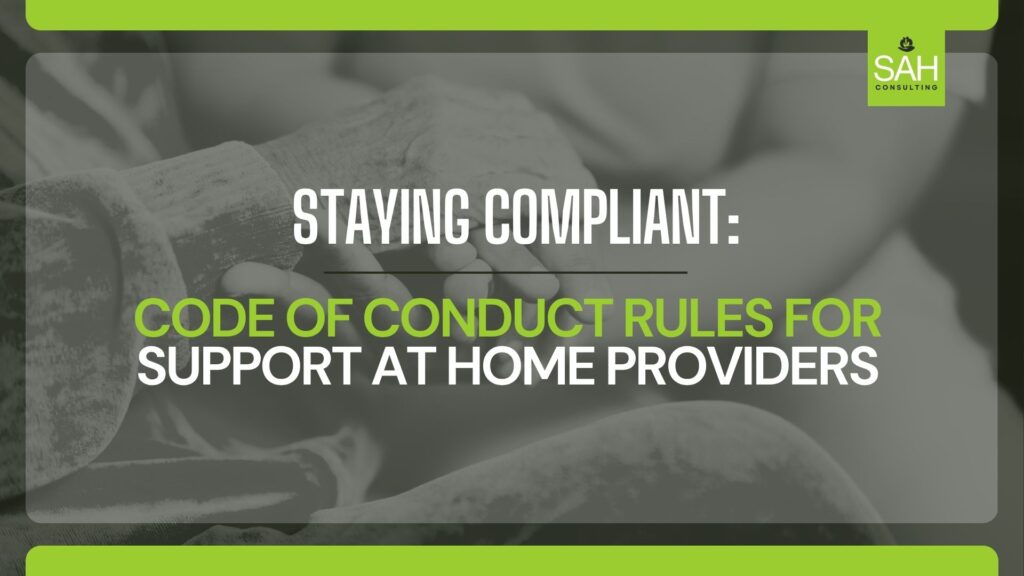From July 2025, the new Aged Care Act will reshape aged care delivery in Australia, prioritising older people’s rights and dignity. For Support at Home Providers, adhering to the Code of Conduct for Aged Care is essential—it forms the basis of the Strengthened Aged Care Standards, ensuring safe, respectful, and person-centred care.
Integrating the Code into your operations is vital to meet these new standards and maintain trust with clients and regulators. In this article, you will learn about the Code of Conduct for Aged Care and how to implement it effectively in your organisation, and how SAH Consulting can support you in this process.
Why the Code of Conduct Matters for Support at Home Providers
The Royal Commission into Aged Care Quality and Safety highlighted major flaws in the sector, showing that the old system favoured providers over individuals. This prompted the rights-based Aged Care Act 2024, which supports the Strengthened Aged Care Standards and establishes the Code of Conduct for Aged Care. The Code outlines clear requirements for providers, governing persons, and workers, including volunteers, to provide care that prioritises older people’s rights, dignity, and safety.
Non-compliance is not just a minor issue—it can result in serious penalties, such as sanctions or banning orders from the Aged Care Quality and Safety Commission. For Support at Home Providers, compliance builds trust, enhances your reputation, and ensures you deliver the high-quality, person-centred care clients expect under Australia’s Aged Care Standards. It demonstrates your commitment to doing things correctly.
Breaking Down the Code of Conduct: 8 Key Behaviours
The Code of Conduct for Aged Care outlines eight essential behaviours that apply to all providers, governing persons, and workers, including volunteers, delivering government-funded aged care. These behaviours, aligned with the Aged Care Standards, ensure older people receive safe and respectful care. So, what are the 8 Standards of aged care? They are:
- Respect rights to freedom of expression, self-determination, and decision-making in line with applicable laws.
- Treat people with dignity, respect, and value their diversity, embracing individual needs and backgrounds.
- Protect personal privacy and sensitive information, keeping client data secure and respecting their preferences.
- Deliver care and services safely and competently, using appropriate skills and equipment.
- Act with integrity, honesty, and transparency, being open about your qualifications and avoiding conflicts of interest.
- Promptly address concerns impacting care quality and safety, reporting issues to reduce risks.
- Provide care free from violence, discrimination, neglect, or abuse, ensuring a safe environment.
- Prevent sexual misconduct and ensure safe care delivery, maintaining professional boundaries.
The Strengthened Aged Care Standards poster, available from the Aged Care Quality and Safety Commission, is a handy visual tool to help providers and staff understand these expectations clearly.
How the Code Integrates with the Strengthened Aged Care Standards
The Code of Conduct for Aged Care works hand-in-hand with the New Aged Care Quality Standards, effective from 1 July 2025, to ensure Support at Home Providers deliver safe, person-centred care under the new Aged Care Act. For Support at Home Providers, here’s how the code integrates with some standards:
- Standard 1: The Person – This standard requires providers to treat older people with dignity, respecting their identity, culture, diversity, and life experiences while supporting informed choices. It aligns with Code behaviours like respecting self-determination (behaviour 1) and valuing diversity (behaviour 2), ensuring care in home settings is tailored to individual needs and preferences.
- Standard 3: Personal and Clinical Care – Focused on delivering safe, effective, and coordinated care, this standard supports Code behaviours requiring competent care delivery (behaviour 4) and preventing abuse, neglect, or discrimination (behaviour 7). It ensures providers meet clients’ personal and clinical needs safely, which is critical in less-supervised home environments.
- Standard 2: The Organisation – This standard emphasises robust governance systems to deliver safe, quality care, including risk management and feedback processes. It aligns with Code behaviours like acting with integrity and transparency (behaviour 5) and promptly addressing concerns (behaviour 6), ensuring providers maintain accountable and responsive operations in the Support at Home Programme.
The Code reinforces these standards by setting clear behavioural expectations for providers, workers, and governing persons.
Practical Steps for Compliance with the Code of Conduct

Meeting the Code’s requirements doesn’t have to be overwhelming. Here are practical steps Support at Home Providers can take to stay compliant:
- Training: Ensure all staff and volunteers complete the free “Know Your Code” learning module from the Aged Care Quality and Safety Commission. This builds a shared understanding of the eight behaviours.
- Policies: Update your policies to reflect the Code, covering privacy, safety, and complaint handling. Clear procedures ensure consistency in care delivery.
- Reporting: Set up robust processes for reporting incidents under the Serious Incident Response Scheme (SIRS), which applies to home care settings. Train staff to act promptly on concerns.
- Documentation: Keep detailed records of care delivery, training, and incident reports to demonstrate compliance during audits.
The Commission’s Code of Conduct fact sheets and worker quick guides are excellent tools to support your team’s understanding and implementation. Start small but start now—compliance is a journey, not a race.
Navigating Challenges in the Support at Home Programme
Adopting the new Act and Support at Home Programme presents challenges, such as training staff and managing client expectations in home settings with less supervision. Supported decision-making, a core element of the new Act, enables older people to make their own decisions with appropriate support.
This requires providers to train staff to handle these discussions with care. The Code ensures accountability, even in home care where oversight is limited. With preparation—using resources like the Commission’s guidance materials—providers can address these challenges and deliver compliant, high-quality care.
How SAH Consulting Can Help You Stay Compliant
Navigating the Aged Care Standards and the Code of Conduct doesn’t have to be daunting. SAH Consulting is your trusted partner, offering tailored support for Support at Home Providers. Our services are all designed to simplify your transition to the new Act. We take a practical approach, ensuring you can focus on delivering exceptional care while we handle the complexities of compliance.
Ready to get started? Visit SAH Consulting’s resources page or contact us for personalised guidance that keeps you ahead of the curve.
Final Thoughts
Compliance with the Code of Conduct is your roadmap to delivering safe, respectful, and person-centred care under the new Aged Care Act. To navigate these changes effectively, it’s essential to understand and embed the eight behaviours outlined in the Code of Conduct. Aligning your operations with the Aged Care Standards will ensure measurable, client-focused outcomes that meet the new requirements.
Preparing for the July 2025 deadline means training staff and updating policies now. Tools like the Aged Care Standards poster can provide clarity and help your team stay on track. For expert support, partnering with SAH Consulting can make navigating compliance simpler and more efficient.
Don’t wait for Transition Day. Contact SAH Consulting today for practical guidance on staying compliant with the Code of Conduct and thriving under the new Aged Care Act.
